Let loose the Prospective: Regrading and Asphalt Sealing for Industrial Areas
Wiki Article
Hot Mix Asphalt: A Lasting Option for Sidewalk
Warm Mix Asphalt (HMA) has become a leading sustainable selection for sidewalk remedies, supplying a myriad of environmental benefits and cutting-edge innovations. Its ability to reduce and recycle products energy consumption provides an engaging case for its fostering in roadway construction tasks. Furthermore, the long-term efficiency and durability of HMA make it a favored choice for framework advancement. As the need for eco-friendly building practices grows, exploring the nuances of HMA's sustainability can offer useful understandings right into the future of pavement solutions.Ecological Advantages of Hot Mix Asphalt

Furthermore, Hot Mix Asphalt helps to reduce urban heat island effects. Its dark color absorbs sunlight, decreasing the amount of heat mirrored back into the ambience compared to lighter-colored sidewalks. This can lower ambient temperature levels in city areas, reducing the need for a/c and inevitably reducing energy intake.
Additionally, Warm Mix Asphalt adds to enhanced stormwater management. Its permeable nature permits water to reenergize and penetrate the sidewalk groundwater supplies, reducing runoff and the danger of flooding. These ecological benefits make Warm Mix Asphalt a sustainable option for paving highways and roadways.
Power Effectiveness in HMA Production
Is power efficiency a vital variable in the manufacturing of Hot Mix Asphalt (HMA)? Power plays a substantial role in the production of HMA, influencing both price and environmental sustainability. One crucial aspect of power efficiency in HMA manufacturing is the use of warm mix asphalt (WMA) innovations.Additionally, innovations in plant modern technologies have actually resulted in even more energy-efficient HMA production processes. Modern plants are developed with features like recycled asphalt pavement (RAP) processing abilities, effective heater systems, and boosted insulation, all contributing to power financial savings. By maximizing power use in HMA production, the market can decrease its carbon impact while preserving premium sidewalk products. Energy efficiency is, for that reason, a crucial factor to consider in ensuring the sustainability of Warm Mix Asphalt production.
Recyclability of Hot Mix Asphalt
The recyclability of Hot Mix Asphalt (HMA) is a critical facet of its sustainability and lasting environmental effect. HMA is one of one of the most recycled materials in the United States, with over 100 million loads of reclaimed asphalt pavement (RAP) being reused yearly in brand-new sidewalk building. Recycling HMA supplies a number of ecological benefits, such as minimizing the need for virgin materials, reducing power usage throughout manufacturing, and decreasing the amount of waste sent to garbage dumps.The process of reusing HMA entails milling the existing sidewalk, squashing it right into smaller items, and blending it with brand-new aggregate and asphalt binder to develop a recycled mix. This recycled mix can commonly carry out in addition to or also much better than traditional HMA, while needing fewer raw products and producing lower greenhouse gas exhausts. By incorporating RAP right into brand-new pavement jobs, roadway companies can conserve natural resources, decrease prices, and reduce the environmental impact of road construction important source and upkeep activities. Generally, the recyclability of HMA plays a substantial duty in promoting sustainable techniques within the sidewalk market.

Long-Term Efficiency of HMA
Asphalt sidewalks show resilience and strength over an extended duration, mirroring the long-lasting efficiency of Warm Mix Asphalt (HMA) The long life of HMA can be attributed to its capability to hold up against heavy web traffic loads, extreme climate problems, and the effects of aging. Researches have actually revealed that properly designed and correctly created HMA sidewalks can check here last for 20 years or even more with normal maintenance. The secret to maximizing the lasting performance of HMA exists in making use of premium products, following ideal techniques in building, and carrying out reliable maintenance techniques. Appropriate water drainage, regular assessments, and timely fixings are important for protecting the structural honesty of HMA pavements gradually. Additionally, improvements in HMA technology, such as making use of polymer-modified binders and warm mix asphalt, have further enhanced the durability and long life of HMA sidewalks. By prioritizing high quality building and construction and maintenance practices, HMA remains to confirm itself as a affordable and lasting option for resilient sidewalk facilities.
HMA: Longevity and Sustainability
Demonstrating both durability and sustainability, Hot Mix Asphalt (HMA) has ended up being a keystone in the building of long-lasting pavement infrastructures - commercial parking lot paving. HMA's durability originates from its capacity to hold up against heavy tons, rough weather, and high website traffic volumes, making it a reputable selection for roadways, freeways, and airport runways. The make-up of HMA, which generally consists link of accumulations, binder, and filler, plays a vital role in boosting its durability and resistance to tear and use
In addition, HMA's sustainability hinges on its recyclability and energy-efficient production process. The ability to recycle reclaimed asphalt pavement (RAP) in new HMA mixes decreases the need for virgin materials and decreases the environmental effect of sidewalk building and upkeep. Additionally, the energy performance of creating HMA depends on its lower mixing temperatures contrasted to other pavement materials, resulting in reduced power usage and greenhouse gas emissions.
Final Thought
In verdict, hot mix asphalt (HMA) offers a lasting solution for pavement with its ecologically pleasant features. HMA's recyclability, power efficiency in production, and long-term sturdiness make it a green choice for roadway building and construction.
HMA is one of the most recycled products in the United States, with over 100 million tons of redeemed asphalt pavement (RAP) being reused each year in brand-new sidewalk building.The procedure of recycling HMA entails grating the existing sidewalk, squashing it right into smaller items, and mixing it with brand-new accumulation and asphalt binder to create a recycled mix.Asphalt pavements demonstrate toughness and durability over a prolonged period, showing the long-lasting efficiency of Hot Mix Asphalt (HMA) In addition, developments in HMA innovation, such as the usage of polymer-modified binders and cozy mix asphalt, have actually further improved the durability and durability of HMA sidewalks. The capacity to reuse redeemed asphalt sidewalk (RAP) in brand-new HMA blends lowers the demand for virgin materials and decreases the ecological effect of sidewalk building and construction and maintenance.
Report this wiki page